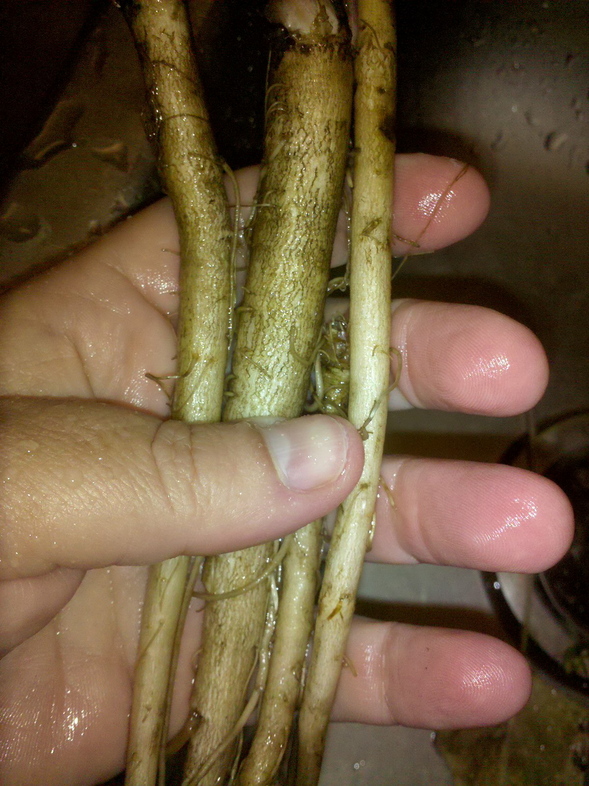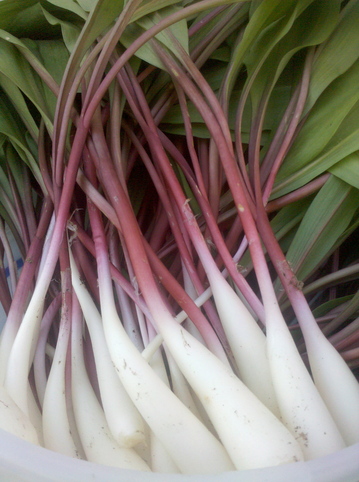Wildcrafting: Kimchi that includes weeds and wild things will warm you up

Burdock root is one of my favorite ingredients in homemade kimchi. It adds an earthy, slightly sweet taste, and pleasantly dense texture to the mix. There are many other wild foods that are great to try in this traditional fermented food.
Linda Diane Feldt | Contributor
Great kimchi will change you inside and out. You will breathe more deeply, your eyes might water, the taste grows in your mouth, and you feel it all the way down. It brings life to simple dishes, and it is the perfect side dish to mix with a main dish or just nibble on a bit on its own and let the tastes explode as well as subtly change your dining experience. You don’t even have to like spicy food —although for most types of kim chi it is essential.
Kimchi has been around for thousands of years, so naturally there are hundreds of varieties and ingredients. Most people think of Chinese or napa cabbage as the primary ingredient. Think of that as just a beginning point. Most kimchi is spicy hot, although it doesn’t need to be. If you are curious, start visiting Korean restaurants in town. I love the kimchi at Bell’s Diner next to Stadium Hardware. I was also impressed with the varieties of kimchi at Seoul Garden on Boardwalk.
Kimchi is easy to make, store and enjoy for months. It is also the perfect thing to share or trade with other kimchi makers. Weeds are great preserved as kimchi. I'm including a very basic recipe you can make and adapt.
My first inspiration to try making kimchi on my own came from the book “Wild Fermentation: The Flavor, Nutrition, and Craft of Live-Culture Foods” by Sandor Ellix Katz. With his recipe as a guide, I made it work for me and some of the wild foods I enjoy.
What wild foods can be enjoyed in kimchi?
Roots - Thin round slices of burdock, wild carrot, dandelion and chicory all work well in kimchi. Use these roots in the spring or fall of their first year, or spring of the second year. Use tender healthy roots, nothing woody or old. I haven’t tried it, but the tender inner roots of cattails should also be good. Wild ginger root would be excellent, ramps (use the whole plant) are perfect, garlic cloves can be wild or cultivated. Jerusalem artichokes are excellent, sliced thin or in chunks.Greens - Wild garlic mustard is a perfect green to add to kimchi. The bitter and garlicky tastes add great flavor to the crock. Dandelion greens, yellow dock greens, wild chives, wild garlic leaves, and whole strands of chickweed are great.
Flowers - Yes, brightly colored flowers can add interest and beauty. Violets, purple dames rocket, comfrey flowers, chopped day lilies (not all are edible — check first), squash blossoms, all would be lovely.

Ramps are a perfect ingredient for kimchi. Use the entire plant, chopped. They can be found in the spring in moist well drained soils. Along the Huron River is a great location for them to thrive.
Linda Diane Feldt
I’d like to try some staghorn sumac berries, mixing cultures and textures. And kimchi may be the perfect way to preserve purslane and benefit from this nutritionally magnificent plant during more of the year. I just haven’t tried it yet. It may turn into a mucilaginous mess, but I’m guessing it will work well.
The above plants are available at widely varying times of the year. Right now, only garlic mustard is easy to find. But you can add frozen treats as well, and some add fresh or frozen fruits to kimchi for a sweeter version. The best idea is to make kimchi often and use whatever wild things and vegetables are in season.
You will need a small crock. Downtown Home and Garden has a nice variety of sizes at a reasonable price. Mine holds about a gallon. Find a ceramic plate that fits inside the crock, but not so tight it is hard to lift out. A weight for the plate, water, great salt (my favorite is sold in bulk at Morgan and York), a variety of chopped vegetables (I use onion, carrot, cabbage, radish, turnip, broccoli, kale and whatever else is around) the weeds and wild food (see above) and a variety of hot peppers and maybe some sweet fruit.
Kimchi is one of those recipes that is very flexible. Precision is not required.
An approximate recipe:
Chop and/or slice a mix of vegetables, about 4 cups. Thin slices allow the brine to better penetrate, and a variety of shapes and densities create a more interesting mouthful. Because this is a fermented product, use toxin-free, organic, well washed veggies. It takes about a week to make this version, based on Sandor Katz’s recipe. Some kimchi is fermented longer, and the above wild ingredients can be adapted for other fermentation methods.
In addition to the wild ideas above, conventional ingredients include radishes (daikon, red, black), cabbage (Chinese, purple, green, napa), carrots, cucumbers, turnips — the list is potentially endless.
Mix about 1 quart warm non-chlorinated water with 3 tablespoons great tasting sea salt. Add veggies and brine to the crock. Submerge the vegetables in the brine. You’ll want to weight down the veggies so that they are all covered. A plate on top with a jar of water to weight it down works well. If the veggies aren’t covered, make more brine.
Let the veggies soak in the brine overnight, or 4-5 hours if you want to finish in one day. After the soaking period, drain the mix, reserving the brine. Taste for saltiness. If it is too salty, you can rinse the vegetables. If not salty enough, add more. How salty is enough? You should taste salt, but it should not be overwhelming. I probably err on the weak side. It is partly a matter of taste, but you want enough to be clearly present. Experiment.
You’ll want to create a spice paste. Ginger, garlic, chilies, maybe even some horseradish root are important ingredients. Suggested amounts are 2-3 tablespoons of finely chopped ginger (although some prefer matchsticks), 3-4 crushed cloves of garlic, 2-3 chilies (dried or fresh can be used - remove seeds), 1-2 teaspoons finely chopped horseradish root and a chopped onion (or scallion, leeks, or chives). Mix together the paste with a bit of water if needed, then mix into the vegetables. Transfer back to the crock, and add back the corrected brine, so that it again covers the vegetables. Use the plate to keep the veggies submerged, place a weight on it if it isn't heavy enough, (I use a small jar filled with water set on the plate) and then cover the crock or jar with a towel or cheesecloth so that no dust or insects can enter.
Taste the mix daily, to note when it tastes “done”. If you aren’t familiar with kimchi, have some friends who can help you, or compare to what you’ve found by exploring local restaurants.
The fermentation can happen in your kitchen, away from heat, in a safe place where it won’t be disturbed but also where it won’t be forgotten. Once you like it, transfer veggies and brine to a large clean jar, with a lid, and store it in the refrigerator. It will last a month or two and continue to ferment in the refrigerator.
For more options on how to make kimchi, and for some history, here are a couple links I found. There is also some writing about the health benefits of kimchi:
A recipe without fermentation, some history, and another person using Sandor's recipe with nice photos.
As you will learn, you can make it more or less fermented, adjust sweetness, and of course the amount of heat is very adjustable. As the ground thaws, dig up some wild roots and try a bit of fermentation. Or just buy some veggies and start experimenting. If you have some recipes or experiences to share, I welcome your comments as well.
Linda Diane Feldt is a local holistic health practitioner, teacher, and writer. You can follow her on twitter, visit her website, and check out her free monthly classes on herbal medicine sponsored by The People's Food Co-op. Her cookbook, "Spinach and Beyond: Loving Life and Dark Green Leafy Vegetables" which does not contain this recipe, is available locally at Morgan and York, Crazy Wisdom Bookstore, Nicola's and can be ordered through Amazon.com.


Comments
krc
Fri, Jan 14, 2011 : 9:35 a.m.
Good Kim chi? Broadway Cafe, hands down.
treetowncartel
Thu, Jan 13, 2011 : 7:58 a.m.
I find the best Kim-Chi in the area to be at BeWon out on Plymouth Road. It accompanies some awesome food!
Vivienne Armentrout
Tue, Jan 11, 2011 : 7:51 p.m.
This is a great inspiration. I've been making homemade sauerkraut for years but haven't overcome inhibitions to try kimchi. Your free-wheeling and confident approach may tip me over the edge. There was a recent article about Katz and fermentation in the New Yorker, very interesting. http://www.newyorker.com/reporting/2010/11/22/101122fa_fact_bilger Also, I'd like to call your attention to the Brinery http://thebrinery.com/, a local producer who sells at the Farmers' Market and elsewhere - his kimchee was great the one time I tried it. I'll use regular pickling salt, though, not sea salt, which is a highly variable material. Not iodized salt!